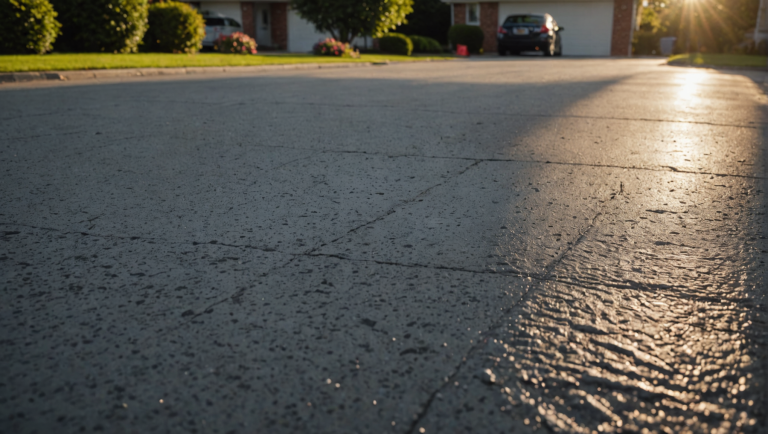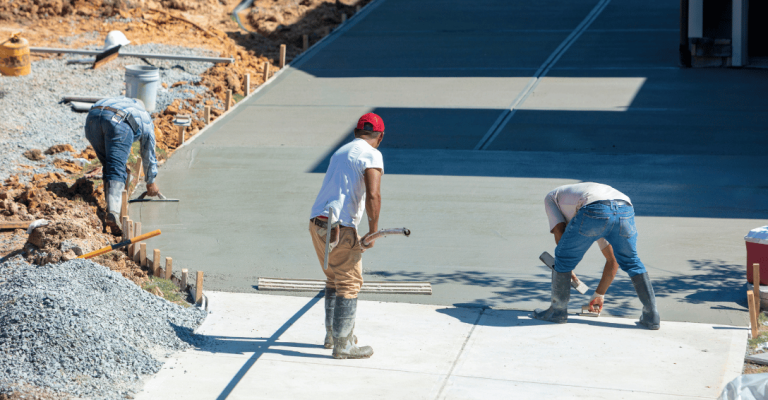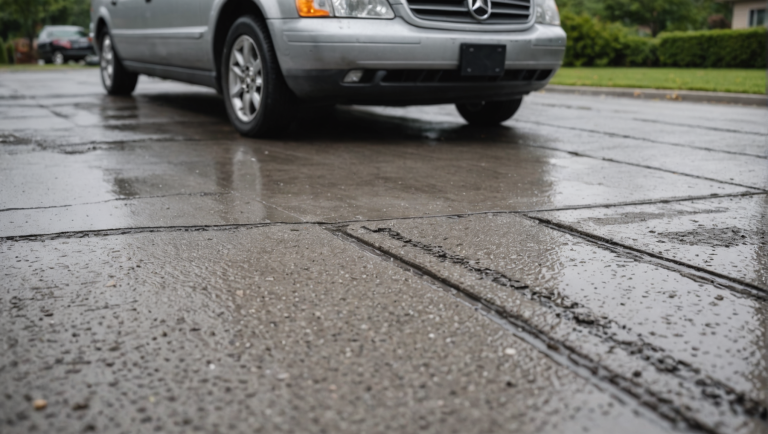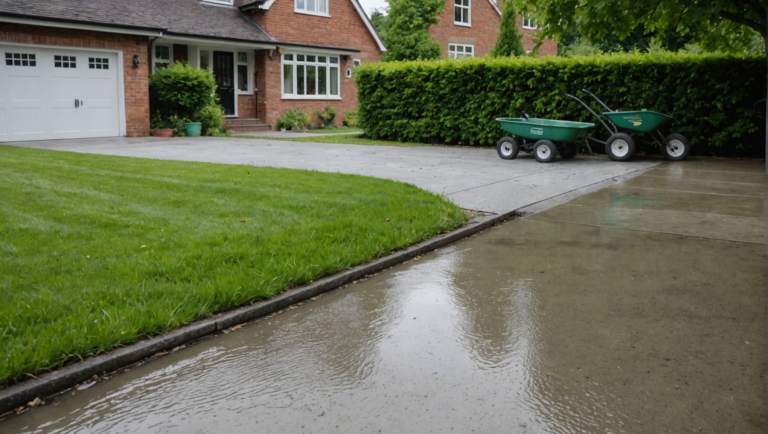Exposed Aggregate Concrete Driveways Elevate Your Homes Curb Appeal
The aesthetic value and durability of exposed aggregate concrete driveways are becoming increasingly recognized by homeowners seeking to enhance their property's curb appeal. These driveways, characterized by their unique blend of cement, water, and various aggregates, offer a striking variety of textures, patterns, and colors. They not only provide a robust and low-maintenance surface but also contribute a touch of elegant sophistication to your home's exterior. How, then, does this driveway style achieve its distinctive appearance, and what makes it a suitable choice for your property? The answers may intrigue you.
Understanding Exposed Aggregate Concrete
Delving into the world of exposed aggregate concrete, understanding its distinctive composition is essential, which involves combining natural or artificial aggregates with cement and water, leading to a robust and visually attractive surface. This composition process is an art form that requires a high level of technical proficiency and understanding of material properties.
Aggregates, the primary constituent of this concrete type, can be either natural like gravel and sand, or manufactured such as crushed stones or slag. The choice of aggregate greatly influences the final appearance and texture of the surface. The cement, which acts as a binder, adheres to the aggregates, providing structural integrity to the concrete.
Once the mixture is poured and the surface smoothed, a retarder is applied to delay the setting of the top layer of cement. This allows the aggregate to be exposed, resulting in a unique, appealing texture. The surface is then washed and sealed to protect the exposed aggregate.
The finished surface provides an aesthetic upgrade to traditional concrete, with a range of colours, patterns, and textures available. Each choice reflects not just the homeowner's style, but also their dedication to a durable, long-lasting driveway surface.
Reasons to Choose Aggregate Driveways
Given the distinctive and appealing nature of exposed aggregate concrete, it's no surprise that numerous homeowners opt for aggregate driveways, and there are several compelling reasons to ponder this choice.
Firstly, exposed aggregate concrete driveways offer a high degree of durability. This material withstands heavy loads and varying weather conditions, making it a reliable option for those seeking longevity. Exposed aggregate concrete is also resistant to skidding, a safety feature that should not be overlooked, especially in areas prone to wet weather.
Secondly, this type of driveway requires minimal maintenance. Regular sweeping and occasional sealing are generally enough to keep the driveway looking fresh and well-kept. This ease of maintenance can save homeowners significant time and effort in the long run.
Lastly, exposed aggregate concrete driveways provide a unique aesthetic appeal. The natural variation in stone colors and sizes creates a visually pleasing texture that can complement any architectural style, enhancing the overall curb appeal of the home.
The combination of durability, low maintenance, and aesthetic charm make exposed aggregate driveways a compelling choice for homeowners seeking to invest in a driveway that not only serves functional purposes but also contributes to the overall aesthetic and value of their property.
Design Possibilities With Aggregate Concrete
The versatility of exposed aggregate concrete opens up a plethora of design possibilities, allowing homeowners to customize their driveways to their personal tastes and the architectural style of their homes. The flexibility of aggregate concrete lies in the range of shapes, colors, and textures it can produce.
Whether it's a sleek, modern design with polished pebbles for a contemporary home, or a rustic, rugged finish with larger stones for a country-style dwelling, the visual effect is stunning.
Selecting the right aggregate is vital to achieving the desired effect. These can range from locally collected stones, to recycled materials, to special imported rocks. The choice of aggregate not only influences the look, but also the strength and durability of the driveway. It's also possible to integrate patterns into the surface of the aggregate concrete, further enhancing its aesthetic appeal.
Moreover, exposed aggregate concrete can be combined with other materials, such as paving stones or bricks, to create a unique and sophisticated look. The diversity of design possibilities with aggregate concrete enables customization that reflects the homeowner's style while seamlessly blending with the home's architectural design.
The result is a durable, functional driveway that adds significant aesthetic value to the property.
Enhancing Curb Appeal With Aggregate
Utilizing exposed aggregate concrete in driveway design greatly enhances curb appeal, creating a visually striking entrance that complements the overall aesthetic of the property. This driveway style is not just functional—it becomes an integral part of the home's design, able to blend seamlessly with a variety of architectural styles.
| Aggregate Type | Curb Appeal Impact |
|---|---|
| Pebble | Adds a natural, earthy look |
| Crushed Granite | Imparts a rustic, rugged appeal |
| Glass | Provides a modern, sleek aesthetic |
| Sea Shells | Lends a coastal, beachy vibe |
The choice of aggregate can be customized to reflect personal style, making the driveway an extension of your home's personality. With their unique textures and rich color palettes, these materials can turn a plain concrete driveway into a stunning landscape feature.
Moreover, the inherent durability of concrete combined with the visual interest added by the aggregate makes for a driveway that is as resilient as it is beautiful. With such a wide range of options available, homeowners can create driveways that truly elevate their property, achieving a curb appeal that is both appealing and unique. This is the power of exposed aggregate concrete driveways.
Cost and Maintenance Considerations
Evaluating the financial implications of exposed aggregate concrete driveways requires a detailed assessment of initial installation expenses, regular upkeep costs, and long-term maintenance strategies. These factors collectively determine the total cost of ownership and, as such, constitute an essential part of the decision-making process.
Next, we will examine each element meticulously to provide a thorough understanding of the economic aspects involved in the implementation and maintenance of these driveways.
Initial Installation Expenses
In considering the initial installation of exposed aggregate concrete driveways, important factors to account for include cost implications and maintenance requirements. The initial outlay for exposed aggregate concrete is typically larger than that of traditional concrete or asphalt driveways. This is due to the complex process involved which requires professional expertise and specialized equipment. Pricing can vary depending on the choice of aggregate, design intricacies, as well as project size and geographical location.
The investment, however, is not without benefits. The durability of exposed aggregate driveways reduces the frequency of expensive repairs often associated with other materials. Moreover, its resistance to harsh weather conditions and heavy traffic, guarantees longevity, making it a cost-effective choice in the long run.
Maintenance requirements for these driveways are relatively low. The initial installation includes a sealing process which protects the aggregate from damage and staining. This sealant typically lasts for a few years before requiring reapplication. This aspect of the installation process can influence the initial cost but results in preservation of the driveway's aesthetic appeal and structural integrity over time.
The initial installation expense of exposed aggregate driveways is a worthy investment, enhancing both the functionality and curb appeal of your property.
Regular Upkeep Costs
Moving from initial installation expenses, it becomes imperative to take into account the regular upkeep costs associated with exposed aggregate concrete driveways. This form of driveway requires a modicum of maintenance to maintain its aesthetic appeal and structural integrity. This includes occasional sealing to prevent water infiltration, which can lead to cracks and damage.
Sealing an exposed aggregate concrete driveway typically costs around $0.50 to $2.50 per square foot, depending on the complexity of the project and local labor rates. This expense should be factored into the overall budget every 2-3 years, depending on climate and usage.
Additional costs may arise from minor repairs such as patching cracks or fixing dislodged aggregate stones. These expenses, although not substantial, can accumulate over time. The cost of repairs will depend on the severity of the damage, but homeowners should budget an extra $50-$200 annually for these potential needs.
Cleaning is another consideration. Professional pressure washing services can cost between $100 and $200 per session, depending on the driveway size. While not a necessity, regular cleaning can enhance the driveway's visual appeal and prolong its lifespan.
Long-Term Maintenance Strategies
Beyond the regular upkeep costs, a thorough understanding of long-term maintenance strategies can aid homeowners in preserving the appearance and durability of their exposed aggregate concrete driveways while effectively managing expenses.
The longevity of exposed aggregate surfaces largely depends on the quality of initial installation and diligent maintenance. Key to this is the application of a professional-grade sealer upon installation and resealing every few years to sustain the surface's aesthetic appeal and structural integrity. A clear, acrylic-based sealer is often recommended due to its UV resistance and ability to protect the aggregate from water damage, oil stains, and other corrosive substances.
Regular cleaning is also essential. It involves sweeping or blowing off debris to prevent staining and scrubbing with a mild detergent to remove tougher stains. Pressure washing should be done meticulously to avoid dislodging the aggregate.
Despite its relatively low-maintenance nature, concrete does undergo natural wear and tear. To mitigate this, consider setting aside a budget for professional resurfacing every decade or so, which involves grinding down the surface and resealing it. This proactive approach ensures your driveway remains in top condition, greatly reduces long-term costs, and enhances your home's curb appeal.
Installation Process of Aggregate Driveways
The installation process of aggregate driveways commences with a thorough preparation phase. This phase is critical to the longevity and aesthetic appeal of the finished product.
After the initial installation, proper aftercare is necessary to preserve the driveway's durability and visual appeal.
We will now examine these key stages in the installation process, detailing the technical aspects and desired outcomes of each.
Preparing for Installation
Proper preparation, an important first step in the installation process of aggregate driveways, involves several vital tasks that guarantee the longevity and durability of the finished product. This phase requires meticulous attention to detail and a clear understanding of the desired final outcome.
The first task is site assessment and preparation. This includes the removal of any existing driveways or landscaping features and leveling of the ground. The area should be surveyed accurately to make sure the driveway fits perfectly within the desired space. Soil conditions must also be evaluated to determine the need for any additional base materials to support the weight of the concrete.
Next, formwork is installed to define the shape and boundaries of the driveway. This structure should be strong and firmly anchored to withstand the weight of the wet concrete.
Following this, a sub-base layer of crushed stone is applied and compacted. This is essential for drainage and to provide a stable base for the concrete.
Lastly, a layer of reinforcement is added, usually steel mesh or rebar, to strengthen the concrete and prevent cracking.
Once these steps have been carefully executed, the site is ready for the concrete pour, marking the beginning of the actual installation process.
Aftercare of Driveways
Once the aggregate concrete driveway is installed, it's essential to follow a structured aftercare routine to safeguard its longevity and aesthetic appeal. This not only improves the driveway's durability but also preserves its visual charm, reflecting positively on your property's overall aesthetic.
The first week post-installation is vital. Avoid vehicular traffic to allow the concrete to cure properly and achieve maximum strength. Regular surface cleaning is necessary to remove any debris that could spoil the appearance or cause erosion. A high-pressure water hose is often adequate for this task.
Sealing the driveway is another important aftercare step. A high-quality sealer, ideally applied 14 days after installation, protects the surface from oil spills, tire marks, and harsh weather, while enhancing the color and texture of the aggregate. Reapplication should occur every two to three years to maintain this protection.
Lastly, the driveway should be inspected periodically for any signs of wear and tear. Prompt repair of cracks or chips will prevent further damage and guarantee the driveway retains its pristine condition.
Through diligent aftercare, your aggregate concrete driveway will continue to enhance your home's curb appeal, providing a welcoming entry point for years to come.
Environmental Benefits of Aggregate Concrete
Harnessing an impressive array of environmental benefits, aggregate concrete is a sustainable choice for constructing driveways. Its composition of natural materials, such as gravel, sand, and water, minimizes the strain on the environment. This construction method leverages locally sourced materials, reducing transportation-related carbon emissions and supporting local economies.
Aggregate concrete's permeable nature is another significant ecological advantage. It allows rainwater to seep through its porous surface and replenish groundwater resources, mitigating issues of runoff and waterlogging. This feature can contribute to the maintenance of local water cycles and the prevention of urban heat island effects.
Let's illustrate these benefits in the table below:
| Factor | Benefit | Impact |
|---|---|---|
| Composition | Uses natural materials | Minimizes environmental strain |
| Sourcing | Locally procured | Reduces carbon emissions, supports local economy |
| Permeability | Allows rainwater seepage | Maintains local water cycles, prevents urban heat islands |
Resilience and Longevity of Aggregate Driveways
Boasting exceptional durability, exposed aggregate concrete driveways stand the test of time, effectively resisting wear and tear from weather elements and daily use. Their robust nature owes much to the high-strength properties of aggregate materials, which are robustly interlocked within the concrete matrix, offering a surface that withstands heavy loads, vehicular movement, and foot traffic.
In addition to their physical resilience, these driveways exhibit an impressive longevity. The unique composition of exposed aggregate concrete allows it to maintain structural integrity and visual appeal, even after years of exposure to external factors. The concrete's natural resistance to ultraviolet radiation prevents color fading, while its superior water resistance mitigates the risk of frost-heave damage and surface spalling.
Furthermore, the aggregate's varied texture provides an intrinsic slip-resistance, enhancing safety during wet conditions or freeze-thaw cycles. The low maintenance requirements of these driveways also contribute to their long lifespan. Regular sealing and occasional power washing are typically all that's needed to preserve their functionality and aesthetic quality.
In essence, the resilience and longevity of exposed aggregate concrete driveways make them a sound investment for homeowners desiring a durable, attractive, and cost-effective solution for their driveways.
Increasing Property Value With Aggregate
Beyond the undeniable durability and aesthetic appeal, exposed aggregate concrete driveways also offer substantial benefits for property value enhancement. This is in part due to its high-end look and the flexibility in design it provides, enabling homeowners to create a custom look that suits their property's style and character.
This form of hardscaping, when implemented correctly, can notably boost your property's curb appeal, a critical factor in determining its worth in the market. The unique beauty of exposed aggregate concrete, combined with its long lifespan and low maintenance requirements, makes it a highly desirable feature for potential buyers. It conveys a sense of quality and permanence, indicating that the homeowner has invested in superior, durable materials.
In addition, the use of exposed aggregate concrete contributes to sustainable building practices, a growing trend in the housing market. It utilizes local, recycled materials, reducing the environmental impact of construction. This eco-friendliness can be a substantial selling point, elevating your property's value in the eyes of environmentally conscious buyers.
Frequently Asked Questions
What Safety Precautions Should Be Taken While Installing Exposed Aggregate Concrete Driveways?
During the installation of exposed aggregate concrete driveways, safety precautions should include wearing protective gear, securing the area, using the correct tools, and following guidelines for safe handling and mixing of concrete materials.
Are There Any Specific Climate Conditions That Affect the Durability of Aggregate Driveways?
Aggregate driveways are generally durable, however, extreme weather conditions like heavy rainfall, freeze-thaw cycles, and prolonged sun exposure can affect their longevity, causing cracks, discoloration, and surface damage over time. Regular maintenance can mitigate these effects.
Is It Possible to Use Recycled Materials in the Creation of Aggregate Concrete?
Yes, it is certainly possible to incorporate recycled materials in the creation of aggregate concrete. Utilizing recycled glass, crushed concrete, or slag can contribute to a sustainable and cost-effective construction process.
What Are Some Potential Zoning or Permit Issues When Installing an Aggregate Driveway?
Potential zoning or permit issues when installing an aggregate driveway may include local restrictions on driveway dimensions, requirements for drainage planning, and regulations on the types of materials allowed for driveway construction.
Can Exposed Aggregate Concrete Driveways Be Installed Over Existing Driveways?
Yes, exposed aggregate concrete driveways can be installed over existing driveways. However, it's important to verify that the existing driveway is structurally sound to prevent any potential issues with the new surface layer.





